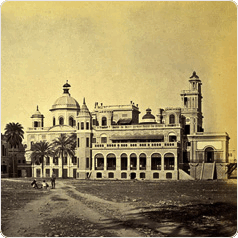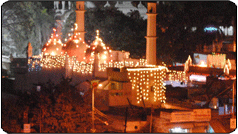
Dargah of Shah Mina Shah
Nearly three hundred years before the arrival of the Nishapuri Nawabs of Awadh and even earlier to the Moghul governors of the State, Lucknow experienced an influx of Sufi saints. Sufis believe in the purification of soul and attainment of virtues through meditation. Like the yogis they shun worldly pleasures and wealth by keeping their desires to the barest minimum. Sufis lead a strictly disciplined lifestyle and some of their mystical practices extend over long periods and require them to abstain from taking food and water. People were soon impressed by their simple living, spiritualistic devotion to God and particularly because they were not averse to other forms of worship, the Sufis had a large following in Awadh. Devotees thronged at their aastaana (abode) in large numbers to pay respects and seek their intervention for fulfilment of their long cherished desires and warding off their ills and sufferings.
Sheikh Qawam-ud-din and his disciple Shah Mina are two of the earliest Sufi saints who have their tombs at Lucknow, now part of the Medical College (of today).
Sheikh Qawam-ud-din belonged to Kara in Allahabad district and had performed pilgrimage to Mecca on foot seven times and was titled Haji-ul-Harmain. Shah Mina was originally named Mohammed and was the son of Qutub-ud-din Siddiqui, who was a relative of Sheikh Qawam-ud-din. The Sheikh had a son who was named Mina, whom he dis-inherited because he did not approve of his son joining the services of the King of Delhi. Qutub-ud-din, blessed by the Sheikh, begot a son whom he named Mina. Qawam-ud-din adopted the child as his disciple and on his death-bed in 1436, nominated him as his successor. Mina's fame as a 'miracle man' spread far and wide and he came to be known as Shah Mina. His aastaana became crowded with devotees and the crowded area around it began to be called Mina Nagri. (Lucknow was then just a small town, and besides the names like Akhtar Nagar and Alakhnau that it had, it was also known as Mina Nagri. Shah Mina died on 23rd Safar, 870 AH (corresponding to 1479 AD). His date of death is recorded in a Persian inscription of 884 AH (mentioned in the proceedings of Asiatic Society of Bengal of 1873).
Both the tombs of Sheikh Qawam-ud-din and Shah Mina were there at their aastaana near Machchhi Bhavan on its east and south-west, respectively. The abodes were demolished with the Machchhi Bhawan by the British, during their conflict with the rebels (freedom fighters) during 1857-58.
The graves were however spared. The road facing the tomb of Shah Mina was renamed as Shah Mina road.
Every Thursday evening, and particularly on Nauchandi Jummeraat (the Thursday following the sighting of new moon), people come in large numbers to recite Fateha (prayer for the dead) and pay their respects to Shah Mina by offering flowers, sweets and a chadar at his mazaar (grave).
In Nawabi days, the holding of the annual urs for commemorating the death of Shah Mina had a mela-like atmosphere. The tradition continues to this day.
Source:
Hindustan Times, A Time in History
Wednesday 8.7.1998 — Shah Mina

